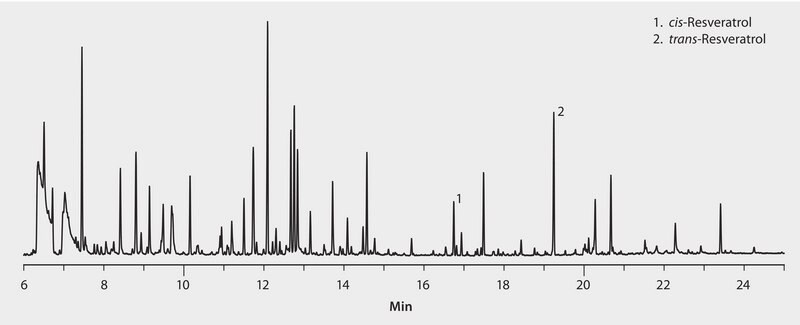GC Analysis of Resveratrol in Red Wine (Spiked) on SLB®-5ms after SPME using a 85 μm Polyacrylate Fiber

材料
分析柱
固相微萃取纖維
標準品
相關產品
附屬品
预组装螺纹口样品瓶,带酚醛树脂顶部开口瓶盖
volume 4 mL, clear glass vial, O.D. × H 15 mm × 45 mm, tan PTFE/silicone septumCONDITIONS
sample/matrix
3 mL of red wine (California merlot) spiked with resveratrol at 100 μg/L then diluted 3:1 in 12% ethanol:water
SPME fiber
85 μm polyacrylate (57304, 57305, 57294-U)
extraction
immersion for 15 min at room temperature while stirring at 400 rpm, fiber gently blotted with a Kimwipe to remove excess water, (then derivatization by immersion in a 4 mL vial containing 5 μL of Sylon-BFT (fresh vial for each analysis than was allowed to equilabrate 60-90 minutes prior to use) for 20 min)
desorption process
280 °C for 2 min
column
SLB-5ms; 30 m x 0.25 mm I.D., 0.25 μm (28471-U)
oven
100 °C (1 min), 10 °C/min to 325 °C (3 min)
inj. temp.
280 °C
detector
GC/MS
MSD interface
325 °C
scan range
m/z 40-450
carrier gas
helium, 1 mL/min, constant
liner
0.75 mm I.D., SPME
sample
Red wine
说明
分析報告
In this study, the extraction and analysis of resveratrol from red wine is demonstrated using solid phase microextraction (SPME) and GC/MS. The presence of three hydroxyl (OH) groups makes it necessary to derivatize this compound prior to GC analysis. Derivatization was conducted, after extraction, directly on the SPME fiber by exposing it to the vapors of a silyating reagent. The derivative of resveratrol was then analyzed directly from the fiber using GC/MS. The polyacrylate fiber, which is suitable for the extraction of polar semivolatiles and is more resistant to swelling than other types of fibers was used in the analysis. The SLB-5ms GC columns provide consistently low-bleed, inert, efficient, and durable separations.
法律資訊
SLB is a registered trademark of Merck KGaA, Darmstadt, Germany